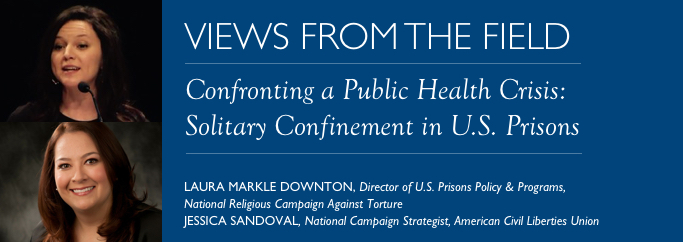
Prison health is a matter of public health. There are 2.2 million people in prison today, most of whom will return to their communities. A lack of quality care inside correctional facilities often results in damaging outcomes, including increased incidence of violence, mental health crises, and high rates of recidivism. The risk of these outcomes is compounded by prison practices, like solitary confinement, which exact a terrible price on the health and well-being of incarcerated people. The United States is a global outlier in its incarceration rates and widespread use of solitary confinement, a common practice in juvenile and adult facilities. According to a recent Bureau of Justice Statistics report, nearly one in five incarcerated Americans, approximately 400,000 people, spent time in solitary confinement over the course of one year. Solitary confinement commonly involves being held alone or with another person in a closed cell—roughly the size of a small closet—for 22 to 24 hours a day, without meaningful human contact, programming, or contact with the outside. Confinement may last for months, years, or even decades. It is typically used as punishment for minor and major rule violations, as well as for “protective custody” for the elderly; young people; lesbian, gay, and transgendered people; and for those who might pose a threat to others. Solitary is often labeled segregation, restrictive housing, isolation, or room confinement. Its duration and justification are neither subject to a judge nor jury, but are left to the discretion of corrections officers. Half of all suicides in prisons and jails occur in solitary confinement. Prolonged isolation is considered a form of torture by the United Nations and other developed countries, yet in the United States it is arbitrarily used for indeterminate periods of time, frequently without recourse.
For those committed to improving U.S. health outcomes, the segregation units found in most jails and corrections facilities are in urgent need of intervention. A growing body of research has established the devastating physical and mental health impacts of solitary confinement on the incarcerated, as well as on corrections staff who work in restrictive housing units. Preventative measures, such as access to sunlight, exercise, and meaningful contact with family, could be offered for little to no cost and could greatly improve the health and well-being of those on the inside. A public health strategy is gaining momentum to challenge the use of solitary by promoting humane alternatives that are grounded in rehabilitative interventions.
The Stop Solitary campaign was established at the American Civil Liberties Union’s National Prison Project in 2010 to significantly reduce the number of incarcerated people held in solitary confinement; to divert youth, individuals with mental illness, and other vulnerable populations out of solitary confinement; to ensure that individuals who develop mental illness as a result of solitary confinement are removed from such units; and to mitigate the damaging effects of solitary confinement by reducing the level of social and environmental isolation routinely used in correctional facilities. Ultimately, the goal is to abolish solitary confinement in favor of more humane and effective prison management.
Calls for humane alternatives to solitary have come in recent years from diverse allies, including the Association of State Correctional Administrators, Pope Francis, former President Obama, Republican and Democratic Governors, and Justices of the Supreme Court. Faith communities and interfaith leaders including the National Religious Campaign Against Torture, as well as medical and mental health professionals, have joined efforts spearheaded by the formerly and currently incarcerated to promote humane alternatives to solitary confinement, with an emphasis on the values of inherent human dignity and public health.
Legislative and administrative reforms to curb the use of solitary confinement are advancing in an ever-growing list of states and jurisdictions. Advanced state campaigns to promote humane alternatives to solitary include New York, where the New York Campaign for Alternatives to Isolated Confinement is working to pass the Humane Alternatives to Long-Term Solitary Confinement Act, which bans prolonged isolation, replacing it with therapeutic interventions that promote public health. Such legislation is serving as a model nationally, with jurisdictions introducing similar bills in Connecticut, New Jersey, Illinois, and Rhode Island. The statewide New York campaign has served as a model for the launch of the neighboring New Jersey Campaign for Alternatives to Isolated Confinement. In October 2016, the Isolated Confinement Restriction Act passed its final vote in the New Jersey Assembly, passing both houses in the state legislature, advancing further than any other progressive legislation on solitary confinement of its kind.
California presents a key example of the reform that is possible when people with first-hand experience and their families lead the fight to end prolonged isolation. Reductions in the numbers in solitary confinement in California state prisons are the result of historic prisoner-led hunger strikes in 2011 and 2013, which garnered the attention of California legislators, as well as national and international audiences. The impact of these hunger strikes was bolstered by strategic organizing by California Families Against Solitary Confinement and their allies in a statewide coalition of grassroots activists. This powerful advocacy supported historic litigation, which reduced the number of people in long-term solitary from over 10,000 to 3,000 people. This number is still far too high, but advocacy and organizing continues, most recently resulting in a California law to protect youth in juvenile facilities from long-term isolation.
The Jacob & Valeria Langeloth Foundation has been a philanthropic pioneer in these efforts. The foundation was the first to fund many of the key national and local groups working on the issue. Now, the foundation’s financial and strategic support is enabling the campaign to expand, incorporating a coordinated grassroots campaign strategy that will focus on greater inclusion of survivor and affected community voices and perspectives, as well as broader public engagement. Langeloth has further responded to the needs of the field by investing in the expansion of this campaign effort and developing and seeding the new Jurisdiction-based Campaign Fund to support state based campaigns. With proven strategies and a growing list of diverse allies, this national and local advocacy campaign presents a prime opportunity for other grant makers investing in public health to further advance these efforts through strategic financial support. It is our goal and aim to see an end to the use of prolonged isolation in our lifetimes. We urge you to join us. Together, we can stop solitary.
What Can Health Funders Do?
- Support policies that expand humane alternatives to solitary confinement, mental health treatment and community based interventions.
- Prioritize grant making to campaigns led by formerly incarcerated people and their loved ones who are leading efforts to end solitary.
- Learn more and educate others. Read Caged In: The Devastating Harms of Solitary Confinement on Prisoners with Physical Disabilities by the ACLU and similar publications, and watch Breaking Down the Box, a film on solitary produced by NRCAT.
For more information, visit:
The Jacob & Valeria Langeloth Foundation: www.langeloth.org
ACLU National Prison Project: www.aclu.org/issues/prisoners-rights/solitary-confinement/we-can-stop-solitary
National Religious Campaign Against Torture: www.nrcat.org
Solitary Watch: www.solitarywatch.org
Stop Solitary for Kids Campaign: www.stopsolitaryforkids.org
California Families Against Solitary Confinement: https://solitarywatch.com/cfasc/
Correctional Association of New York: www.correctionalassociation.org/issue/solitary-confinement

